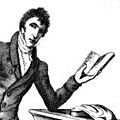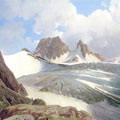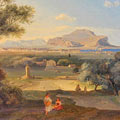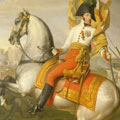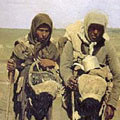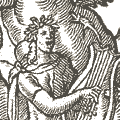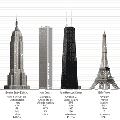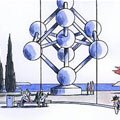gisterenavond gezien op Animal Planet: Planet Earth
Animal Planet een dochter van Discovery Channel, is gisterenavond begonnen met het uitzenden van de indrukwekkende BBC serie Planet Earth uit 2006 met voice over van de onvergetelijke David Attenborough. Het eerste deel begint met een ijskoude scene op Antarctica. Wanneer wij hier liggen te zweten op het strand van Zandvoort, staan de koningspinguïns minstens zo dicht op elkaar bij onbegrijpelijke temperaturen van 70 graden onder nul te overwinteren. Tijdens de arctische winter blijft de zon vier maanden lang weg; dit zijn de meest barre omstandigheden die je je kunt voorstellen. Maar de ontberingen van de dappere koningspinguïn worden in het voorjaar beloond als het langgekoesterde ei is uitgekomen. Extreem moedergeluk dus. Ook een heel grappige scene met een baltsende paradijsvogel op Nieuw-Guinea voorzien van droog Brits commentaar. En net zoals in Deep Blue een bloedstollende scene met zeerob en grote gevaarlijke vis.
uniek fragment uit Planet Earth waarin een zeerob door een witte haai wordt aangevallen
Het eerste deel van Planet Earth wordt deze week verschillende malen herhaald, o.a. morgen 21 oktober om 20.00 herhaald en woensdag 22 oktober om 14.00 ‘s middags. Volgende week zondag 26 oktober volgt deel 2.
the definitive look at
the diversity of our planet
The first episode illustrates a ‘journey’ around the globe and reveals the effect of gradual climatic change and seasonal transitions en route. During Antarctica’s winter, emperor penguins endure four months of darkness, with no food, in temperatures of –70°C. Meanwhile, as spring arrives in the Arctic, polar bear cubs take their first steps into a world of rapidly thawing ice. In northern Canada, the longest overland migration of any animal over 2000 miles is that of three million caribou, which are hunted by wolves, and one such pursuit is shown. The forests of eastern Russia are home to the
Amur leopard: with a population of just 40 individuals, it is now the world’s rarest cat. This is primarily because of the destruction of its habitat, and
Attenborough states that it “symbolises the fragility of our natural heritage.” However, in the tropics, the jungle that covers 3% of the planet’s surface supports 50% of its animals. Also depicted is the one-second strike of a great white shark as it pounces on a seal, slowed down forty times. Other species shown include
New Guinea’s birds of paradise, African hunting dogs in their efficient pursuit of impala, elephants in Africa migrating towards the waters of the
Okavango Delta, a seasonal bloom of life in the otherwise arid
Kalahari Desert, and 300,000 migrating Baikal teal, containing the world’s entire population of the species in one flock. The Planet Earth Diaries segment shows how the wild dog hunt was filmed unobtrusively with the aid of the
Heligimbal: a powerful, gyro-stabilised camera mounted beneath a helicopter.
en.wikipedia.org
de Heligimbal onder een helicopter
Planet Earth was co-produced with Discovery Channel and the NHK in association with the CBC, and was described by its makers as “the definitive look at the diversity of our planet”. It was also the first of its kind to be filmed entirely in high-definition. The series was nominated for the Pioneer Audience Award for Best Programme at the 2007 BAFTA TV awards.
planet earth [ official website ] | meer fragmenten uit Planet Earth op youtube.com


